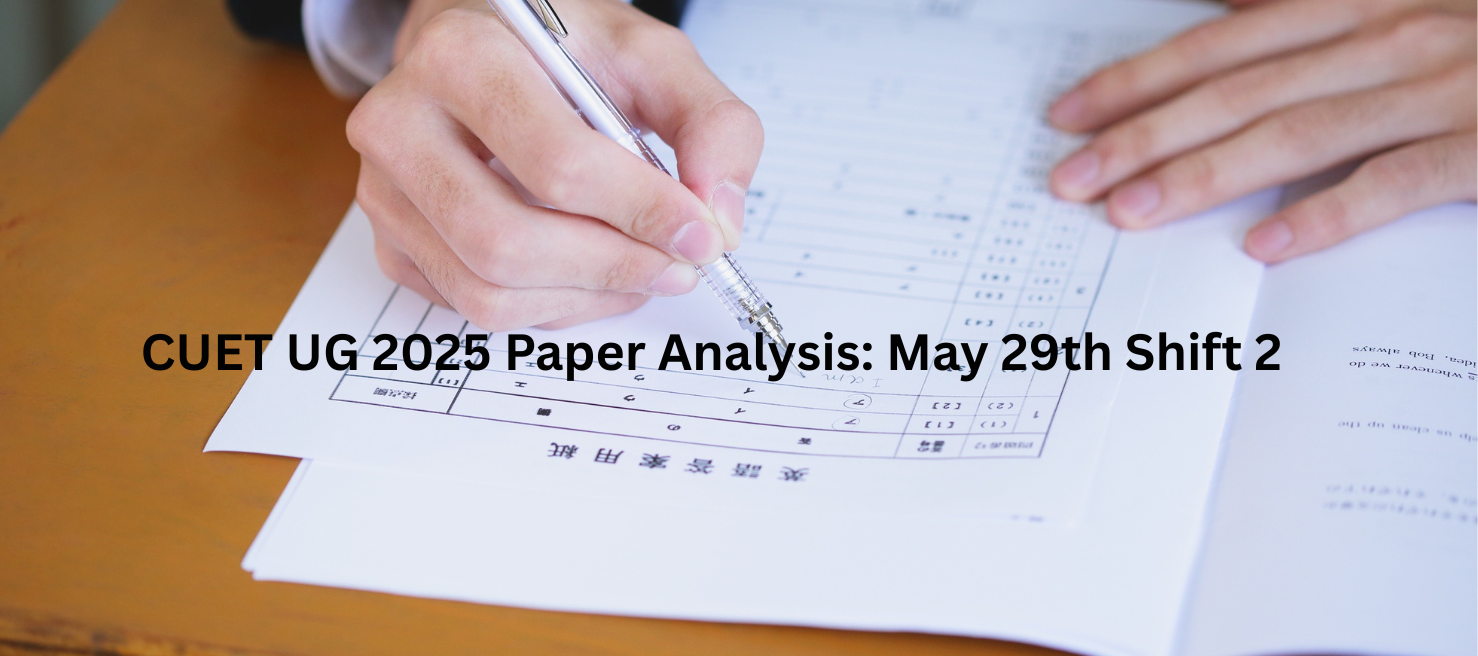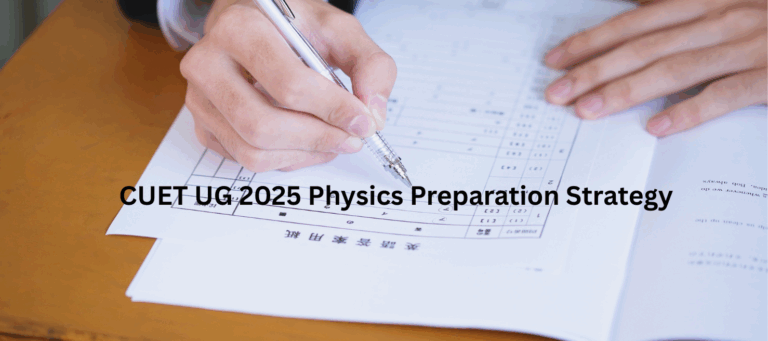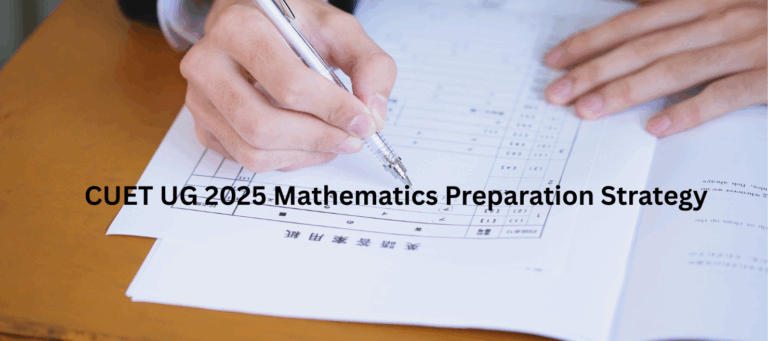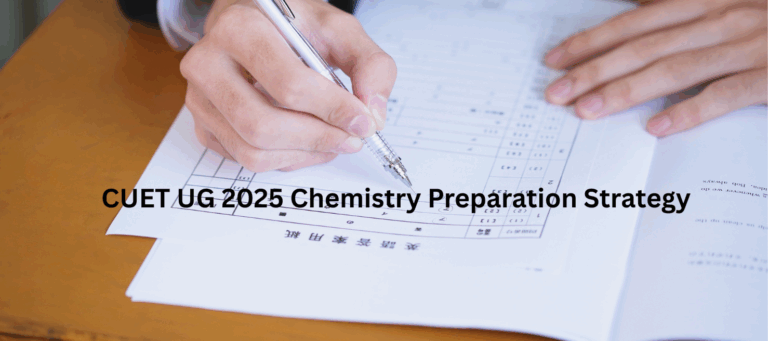
The CUET UG 2025 May 29th Shift 2 exam struck a balanced mix of conceptual clarity and application-based questions across subjects, challenging students to apply both speed and precision. General Aptitude (GAT) covered current affairs, logical reasoning, and numerical ability, testing students’ analytical depth, while Physics leaned heavily on numerical problem-solving, particularly in Modern Physics, Units, and De Broglie’s theory. Mathematics was considered easy yet calculation-intensive, with a focus on Calculus, Matrices, and Vectors, while Economics required conceptual understanding and application of theories, with questions from Micro and Macro topics in equal weight. The exam was rated moderately difficult overall, with time management emerging as a key challenge.
CollegeDost’s detailed analysis breaks down the chapter-wise weightage, question patterns, and difficulty levels, helping students prepare smarter for upcoming CUET shifts.
- May 13th CUET UG Paper Analysis Shift 1
- May 13th CUET UG Paper Analysis Shift 2
- May 14th CUET UG Paper Analysis Shift 1
- May 14th CUET UG Paper Analysis Shift 2
- May 15th CUET UG Paper Analysis Shift 1
- May 15th CUET UG Paper Analysis Shift 2
- May 16th CUET UG Paper Analysis Shift 1
- May 16th CUET UG Paper Analysis Shift 2
- May 19th CUET UG Paper Analysis Shift 1
- May 19th CUET UG Paper Analysis Shift 2
- May 20th CUET UG Paper Analysis Shift 1
- May 20th CUET UG Paper Analysis Shift 2
- May 21st CUET UG Paper Analysis Shift 1
- May 21st CUET UG Paper Analysis Shift 2
- May 22nd CUET UG Paper Analysis Shift 1
- May 22nd CUET UG Paper Analysis Shift 2
- May 23rd CUET UG Paper Analysis Shift 1
- May 23rd CUET UG Paper Analysis Shift 2
- May 24th CUET UG Paper Analysis Shift 1
- May 24th CUET UG Paper Analysis Shift 2
- May 26th CUET UG Paper Analysis Shift 1
- May 26th CUET UG Paper Analysis Shift 2
- May 27th CUET UG Paper Analysis Shift 1
- May 27th CUET UG Paper Analysis Shift 2
- May 28th CUET UG Paper Analysis Shift 1
- May 28th CUET UG Paper Analysis Shift 2
- May 29th CUET UG Paper Analysis Shift 1
- May 30th CUET UG Paper Analysis Shift 1
- May 30th CUET UG Paper Analysis Shift 2
- May 31st CUET UG Paper Analysis Shift 1
- June 2nd CUET UG Paper Analysis Shift 1
- June 2nd CUET UG Paper Analysis Shift 2
- June 3rd CUET UG Paper Analysis Shift 1
- June 3rd CUET UG Paper Analysis Shift 2
CUET UG 2025 Exam Overview
Below is the exam overview of CUET UG 2025.
| Exam Particulars | Exam Details |
| Total Subjects Offered | 37 (13 Languages + 23 Domain Subjects + 1 General Aptitude Test) |
| Medium | 13 Indian languages (Assamese, Bengali, English, Gujarati, Hindi, Kannada, Malayalam, Marathi, Punjabi, Odia, Tamil, Telugu, and Urdu) |
| Subjects to Choose | Up to 5 subjects |
| Total Marks of CUET Exam | 250 |
| Questions per Subject | 50 Compulsory Questions |
| Marking Scheme | +5 for correct answer, -1 for incorrect answer, and no marks for unattempted questions |
| Exam Mode | CBT Mode |
| Duration | 60 minutes per subject |
Where To Check CUET UG 2025 Paper Analysis
The CUET exam date 2025 of May 29th, shift 2, for the GAT, Physics, Chemistry, and English paper. As per the initial reaction of the students, the exam for the Shift 2 is considered to be easy to moderate. Check out the subject-specific analysis and weightage of each chapter.
👉 Check CUET UG 2025 Exam Analysis on CollegeDost
CUET UG 2025 Exam: Shift Timings Today
Check the CUET UG 2025 exam shift timings in the table below.
| CUET UG 2025 Slot Time for 29th May | Reporting Time | Gate Closing Time | Shift Timing |
| CUET UG 2025 Shift 1 | 7 AM | 8.30 AM | 9 AM to 12 PM |
| CUET UG 2025 Shift 2 | 1 PM | 2.30 PM | 3 PM to 6 PM |
CUET Exam Pattern 2025
The CUET UG 2025 exam is structured to assess various skills across multiple subjects. Below is a detailed breakdown of the exam pattern:
| Sections | Subjects / Tests | No. of Questions | Question Type |
| Section IA | 13 different languages (any one can be chosen) | 50 | Reading Comprehension based on different types of passages – Factual, Literary, and Narrative; includes Literary Aptitude and Vocabulary |
| Section II | 23 domain-specific subjects (choose as per eligibility) | 50 | MCQs based on the NCERT Class XII syllabus |
| Section III | General Test (for programs where it’s used for admission) | 50 | General Knowledge, Current Affairs, General Mental Ability, Numerical Ability, Quantitative Reasoning (up to Grade 8 level), Logical and Analytical Reasoning |
CUET UG 2025 Exam Analysis: Based on Number of Attempts
Candidates can check the number of good attempts that they can expect in the exam from the following table.
| CUET UG Subjects | Difficulty Level | Good Attempts |
| English | Easy | 42 – 47 |
| General Aptitude Test | Easy to Moderate | 40 – 45 |
| Chemistry | Moderate to Difficult | 35 – 40 |
| Economics | Moderate | 38 – 43 |
| Business Studies | Easy | 42 – 46 |
| Accountancy | Moderate | 37 – 42 |
CUET UG 2025 Exam Analysis: May 29 2025, Shift 2
The CUET exam date 2025 of May 29th, shift 2, for the GAT, Physics, Mathematics, and Economics paper. As per the students’ initial reaction, the exam for the Shift 2 is considered . Check out the subject-specific analysis and weightage of each chapter.
CUET UG 2025 GAT Paper Analysis
Students found questions on constitutional amendments, especially about the voting age, quite relevant and expected. Many noticed the Hirakud Dam question, which focused on the Mahanadi river, and appreciated its emphasis as India’s longest dam. Questions on classical dances, particularly the recognition of Sattriya dance in 2000, were common and well-prepared for. Students found the Arunachal Pradesh border questions tricky, especially identifying Bangladesh as a state not share a boundary. The sequence of historical dynasties was tested using a mnemonic, which helped many. Chemical formula and isoelectronic species questions appeared, and students who matched element symbols confidently did well. Overall, students felt revising all previous GK parts was crucial, as some questions repeated exactly from past sessions.
| Topic | Question / Focus | Key Details / Answer |
| Constitutional Amendments | Question on Voting Age amendment | Specific amendment on voting age |
| Hirakud Dam | The river on which the Hirakud Dam is built | Mahanadi River, the longest dam in India |
| Classical Dance | Dance added to classical category on 15 Nov 2000 | Sattriya dance (Assam) |
| Arunachal Pradesh Borders | Which country/state does NOT share boundary | Bangladesh (not bordering) |
| Historical Dynasties Sequence | The order of dynasties asked | Mnemonic: “Gul khilaya Tuglak ne” |
| Chemical Formulae | Match elements with symbols | Au = Aurum (Gold), Cu = Copper, Fe = Iron |
| Isoelectronic Species | Definition and identification | Isoelectrons = species with equal electrons |
| Exam Preparation | Importance of revising covered GK Parts 1-10 | Exact questions repeated; recommended PDFs |
General Awareness-Chapterwise Weightage
This section highlights the importance and distribution of the various topics within the field of general awareness. Recognizing the importance given to each chapter can improve overall assessments related to general awareness.
| Category | Expected Questions |
| Geography | 7 |
| Science | 4 |
| Personalities | 4 |
| Polity | 3 |
| Defence | 2 |
| Awards | 2 |
| Sports | 1 |
| Currency | 1 |
| Miscellaneous | 1 |
Logical reasoning-Chapterwise Weightage
| Topic | Expected Questions |
| Visual Reasoning | 4 |
| Series | 2 |
| Coding-Decoding | 2 |
| Arrangement | 2 |
| Clocks | 2 |
| Analogy | 1 |
| Family Tree | 1 |
| Calendar | 1 |
| Data Sufficiency | 1 |
| Directions | 1 |
| Statement-Conclusion | 1 |
Numerical Ability-Chapterwise Weightage
| Topic | Expected Questions |
| Time and Work | 2 |
| Ratio | 2 |
| Simplification | 1 |
| Fractions | 1 |
| HCF-LCM | 1 |
| Problems on Age | 1 |
| Percentage | 1 |
| Profit, Loss & Discount | 1 |
| Simple Interest | 1 |
| Area | 1 |
| Volume | 1 |
| Speed, Time, Distance | 1 |
| Mean & Mode | 1 |
| Triangle | 1 |
| Trigonometry | 1 |
CUET UG 2025 Physics Paper Analysis
Students found the Physics paper moderately difficult, with speed being crucial to complete it on time. Numericals mainly came from chapters 1, 2, 4, and 9, which many felt were time-consuming and challenging. Questions on units from chapter 5 were also present but manageable. Modern Physics gained more focus, especially topics like Dual Nature, Atom, and Nuclei, with tricky theory questions. Many students struggled with calculation-heavy problems based on De Broglie’s hypothesis, finding the paper formula-intensive and tough overall.
| Topic | Details / Observations | Recommendations / Notes |
| Overall Level | Physics paper described as Moderate | Speed is important to attempt the entire paper |
| Numericals | From Chapters 1, 2, 4, 9; tough/time-consuming | Practice these chapters thoroughly |
| Units | Questions from Chapter 5 | Focus on unit conversions |
| Modern Physics | Increasing importance; theory-based and tricky questions | Study Dual Nature, Atom, Nuclei, Chapter 14 |
| De Broglie’s Hypothesis | Questions on $\lambda = h/p$ with variations in parameters | Expect calculation-heavy, formula-based problems |
| Student Feedback | Paper tough and calculation-intensive; formula-heavy | Be prepared for high difficulty numericals |
CUET Physics – Chapterwise Weightage
The table below highlights the importance and distribution of different subjects within the Physics subject.
| Sections | Number of Questions |
| Electrostatics | 8 |
| Current Electricity | 7 |
| Magnetic Effects of Current and Magnetism | 8 |
| Electromagnetic Induction & A.C. | 6 |
| Electromagnetic Waves | 1 |
| Optics | 8 |
| Dual Nature of Matter and Radiation | 5 |
| Atoms and Nuclei | 4 |
| Electronic Devices | 3 |
CUET UG 2025 Chemistry Paper Analysis
Students found the Mathematics paper in the evening shift easy overall, aligning with their expectations. Many noticed 6-7 questions on Matrices and Determinants, especially on the adjoint property, though inverse determinant questions were absent. Calculus dominated the paper with 15-20 questions, and those who practiced well found it manageable. Differential Equations were easy, including questions on degree and order. Topics like Continuity, Application of Derivatives, and Differentiation appeared with a few questions each. Probability had two questions focused on Conditional Probability and Independent Events, but no Bayes Theorem questions. Students found Vector and 3D Geometry challenging, especially the Shortest Distance and Angle between Lines, which they were advised to practice thoroughly. Linear Programming had 3-4 questions, with some advising to attempt time-consuming feasible region problems last.
| Topic | Details / Observations | Recommendations / Notes |
| Overall Level | The mathematics paper is described as Easy | Consistent with overall trend |
| Matrices & Determinants | 6-7 questions; included adjoint property; no inverse determinant questions | Practice statement-based questions |
| Calculus | 15-20 questions covering various topics | Significant portion; easy if well practiced |
| – Differential Equations | Easy level; questions on degree, order, and linear differential equations | Focus on basics of differential equations |
| – Differentiation | 2 questions on dy/dx calculation | – |
| – Continuity | 1 question | – |
| – Application of Derivatives | 4-5 questions from Rate & Measurement, Increasing/Decreasing Functions, Maxima/Minima | – |
| Probability | 2 questions on Conditional Probability and Independent Events | No Bayes Theorem questions; match the following format included |
| Inverse Trigonometric Functions | 1-2 questions | – |
| Relation & Function | 1 question; simple topic | – |
| Vector & 3D Geometry | 3-4 questions; important topics include Shortest Distance & Angle between Lines | Practice formulas and problems carefully |
| Linear Programming Problem (LPP) | 3-4 questions; includes value calculations | Attempt the time-consuming feasible region questions last |
CUET Chemistry-Chapterwise Weightage
The table below highlights the importance and distribution of different subjects within the Chemistry subject.
| Topics | Number of Questions |
| Solid State | 4 |
| Electrochemistry & Solutions | 5 |
| Chemical Kinetics | 2–3 |
| P Block Elements | 2–3 |
| D and F Block Elements | 5 |
| Coordination Compounds | 5–6 |
| Alcohols, Phenols, and Ethers | 4–5 |
| Aldehydes, Ketones, and Carboxylic Acids | 3–4 |
| Organic Compounds Containing Nitrogen | 4 |
| Polymers | 1–2 |
| Chemistry in Everyday Life | 1–2 |
CUET UG 2025 Economics Paper Analysis
Students found the paper concept-heavy and challenging, with about 60% of questions from Microeconomics and 40% from Macroeconomics. Many faced chronology-based questions on key economic texts from 1919 and 1936. National Income questions were mostly matching types on GDP and GNP formulas, with no direct numericals. Numericals on excess demand, cost formulas, AD-AS, and Money and Banking required good calculation skills. Theory questions on Balance of Payments tested conceptual understanding. Match-the-following questions covered price controls and unemployment types. Students also encountered conceptual questions on marginal rates and profit ratios, especially their impact on the Production Possibility Curve, demanding clear conceptual clarity.
| Topic | Details / Observations | Notes |
| Overall Paper | Concept-heavy and challenging | Prepare for both theory and application |
| Microeconomics | 60% of questions focused here | Key focus area |
| Macroeconomics | 40% of questions | Important to balance study |
| Chronology Questions | Included historical works: Economic Consequences of the Peace (1919), General Theory (1936) | Know important economic literature |
| National Income | Matching questions on GDP, GNP, and formulas | No direct numericals from this topic |
| Numericals | Questions on excess demand, cost formulas, and AD-AS numericals | Practice application of numericals |
| Money and Banking | Numerical questions | Focus on calculations |
| Balance of Payments (BoP) | Theory-based questions | Understand concepts thoroughly |
| Match the Following | Included price ceiling, price floor, and unemployment types | Concept clarity needed |
| Conceptual Questions | Marginal Rate of Exchange, Substitution, Transformation, Profit Ratio | Know the effects on the Production Possibility Curve (PPC) |
CUET Economics Chapterwise Weightage
The table below highlights the importance and distribution of different subjects within the Economics subject.
| Chapter/Topic | Number of Questions |
| Consumer Behavior and Demand | 6–7 |
| Introductory Microeconomics | 2 |
| Balance of Payments | 4–5 |
| Government Budget and the Economy | 3–4 |
| Determination of Income and Employment | 3–4 |
| National Income | 3–4 |
| Money and Banking | 2–3 |
| Rural Development | 4–5 |
| Indian Economy (1950–1990) | 2–3 |
| Infrastructure | 2–3 |
| Development Experiences of India (Comparison with Neighbors) | 2–3 |
| Indian Economy on the Eve of Independence | 1–2 |
| Economic Reforms since 1991 | 1–2 |
Student Reviews For CUET UG 2025 May 29th Shift 2 Exam
Most students from different states found CUET UG 2025 Shift 2, which was held on May 29th, Shift 2 . Here is a summary of what students perceived about the exam.
| Section | Difficulty Level | Student Feedback |
| General Test (GAT) | Easy to Moderate | Students found the reasoning and language comprehension sections straightforward. However, the quantitative aptitude part was time-consuming due to lengthy calculations, requiring careful time management. |
| English | Easy | The English section was generally considered easy. Vocabulary questions were manageable, and reading comprehension passages were clear and concise. |
| Domain Subjects | Moderate to Difficult | Subjects like Chemistry and Biology were reported to be challenging. Chemistry, in particular, had a significant focus on conceptual understanding and numerical problems, especially in inorganic chemistry. Biology was easier but required good time management due to the length of the paper. |
CUET UG 2025 Exam Day Guidelines
Given below are a few CUET UG 2025 exam day guidelines that students need to follow.
- Carry Only Required Items: Only take your printed admit card (with passport-size photograph), your valid photo ID (Aadhaar or PAN card), a transparent ballpoint pen, and a transparent water bottle. Candidates can check all the CUET exam details on the admit card and are advised to adhere to the instructions.
- Be On Time: Report to the exam center well in advance relative to your reporting time (7:00 AM for Shift 1 and 1:00 PM for Shift 2). If you are late, you will not be allowed to enter.
- Prohibited Items: Do not bring mobile phones, smart watches, electronic devices, bags, books, or food if not medically required (with documentation).
- Maintain Discipline: Be seated in your assigned seat, only do rough work on the sheets provided, and do not perform any unfair practice or make any noise in the exam hall.
- Time Management: It is a critical challenge across subjects, especially with lengthy sections like RC or Quant. It’s advised to tackle easy questions first.
- The Normalisation Factor: This factor will account for variations in difficulty across shifts. The focus should be on attempting as many questions with 100% accuracy.
CUET Dress Code For Females
| Category | Allowed | Not Allowed |
| Clothing | Half-sleeved, simple kurtis/tops | Full-sleeved, heavily embroidered, or layered clothing |
| Bottom Wear | Simple leggings, trousers, salwar | Skirts, jeans with extra pockets |
| Footwear | Slippers, flat sandals | Heels, closed-toe shoes, boots |
| Accessories | None | Jewelry (earrings, rings, bangles, bracelets, belts) |
| Electronic Items | None | Smartwatches, Bluetooth devices, and wired accessories |
CUET Dress Code 2025 for Males
| Category | Allowed | Not Allowed |
| Clothing | Half-sleeved, plain shirts or t-shirts | Full-sleeved shirts, layered clothing, and embroidery |
| Bottom Wear | Light trousers, simple jeans | Cargo pants, jeans with too many pockets |
| Footwear | Slippers, sandals | Shoes, sneakers, boots |
| Accessories | None | Watches, belts, caps, sunglasses, metallic items |
| Electronic Items | None | Smartwatches, Bluetooth devices, and wired accessories |
Things Allowed Inside the Examination Hall
- Transparent Water Bottle
- Admit Card (printed copy)
- Face Mask & Gloves (if applicable)
- Personal Hand Sanitiser (50 ml)
- Rough Sheets (provided by the exam centre)
- Passport-size Photograph (same as uploaded in the application)
- Simple Black/Blue Ballpoint Pen (if specified)
- Valid Photo ID Proof (Aadhar, PAN, Passport, etc.)
Things Not Allowed Inside the Examination Hall
- Books, Notes, or Any Study Material
- Mobile Phones & Smartwatches
- Wallets, Handbags, Sunglasses
- Bags, Pouches, or Any Items with Metal Components
- Electronic Gadgets (earphones, calculators, etc.)
- Jewellery, Caps, or Hats
- Food or Drinks (except water)
- Any Written or Printed Papers
What’s New In CUET UG 2025?
Check out some new changes introduced by UGC and which will be implemented from CUET UG 2025 onwards.
- Students can now take CUET UG exams in any subject, regardless of their Class 12th subjects.
- CUET UG will be conducted solely in CBT mode.
- CUET subjects have been reduced to 37 from 63. Teaching Aptitude, Entrepreneurship, and Legal Studies subjects has been removed.
- The duration of the test is 60 minutes for all the subjects.
- The GAT scores will decide the admission for the removed CUET subjects.
- There will be no optional questions.
Frequently Asked Questions
1. Which subjects were included in Shift 2?
Shift 2 of the CUET UG 2025 on May 29 included the General Test and English subjects.
2. What was the overall difficulty level of the Shift 2 exam?
The overall difficulty level of the exam was reported as moderate. The question pattern remained consistent, allowing many candidates to manage their time well and attempt the paper comfortably.
3. What was the structure and difficulty level of the General Test?
The General Test consisted of 50 multiple-choice questions, out of which candidates were required to attempt 40. The questions covered topics like General Knowledge, Current Affairs, General Mental Ability, Numerical Ability, Quantitative Reasoning (up to Grade 8 level), and Logical and Analytical Reasoning. The difficulty level was considered moderate.
4. What are the next steps after the exam?
After the exam:
Keep an eye on the official CUET UG website for updates on answer keys and results.
Participate in counselling sessions as per the schedule released by the respective universities.
Prepare the necessary documents for the admission process.






